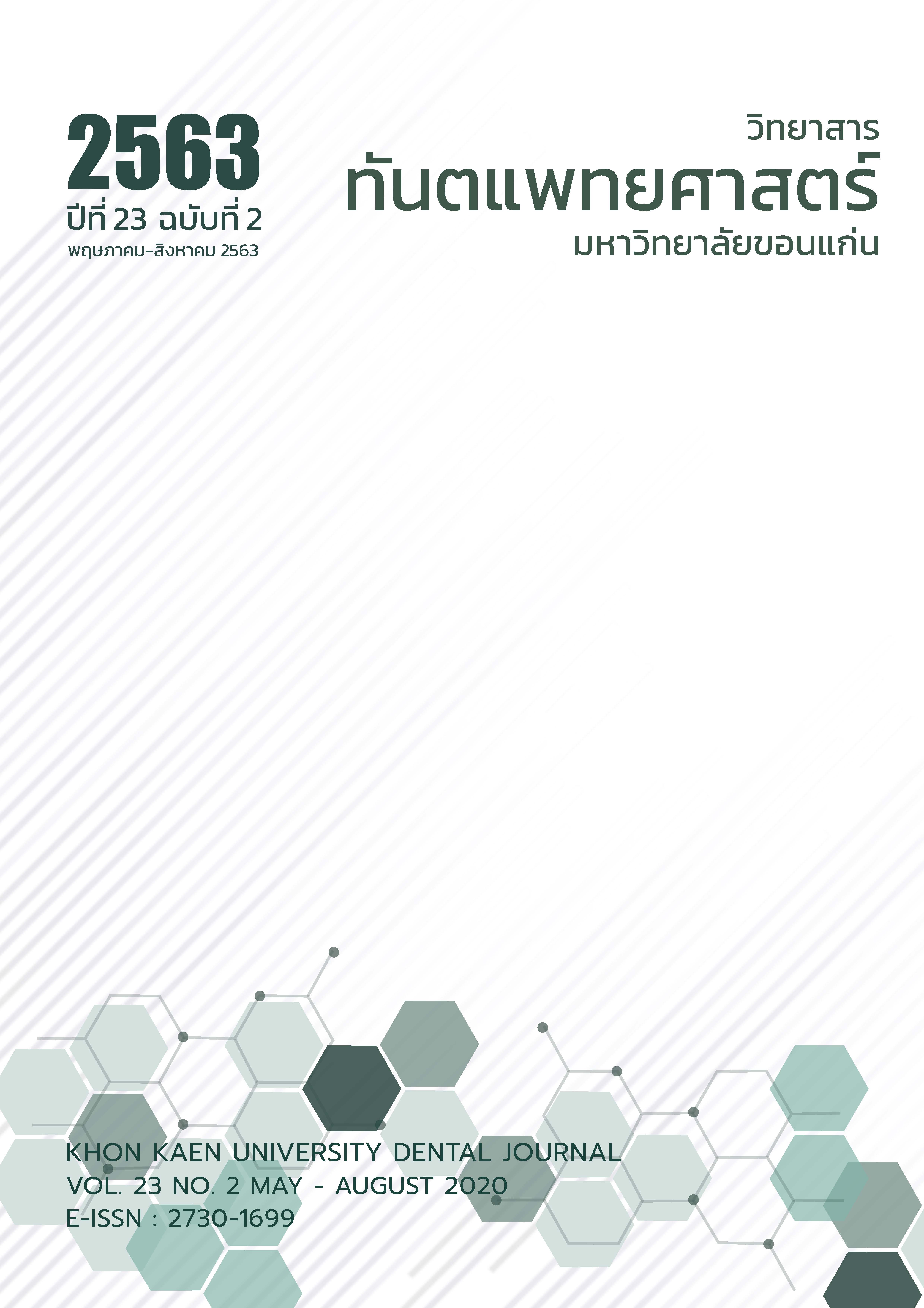Number and Type of Primary Teeth in the Oral Cavity among Thai Children Aged 9-30 Months at the Well Baby Clinic, Srinagarind Hospital, Faculty of Medicine, Khon Kaen University
Main Article Content
Abstract
In Thailand, an estimation of the eruption age of the primary dentition in Thai children is based on international studies using references criteria that apply to different ethnic groups. Certain discrepancies, due to ethnic factors, may bias the evaluation of normal tooth eruption age in Thai children. This study aims to estimate number and describe the types of primary teeth that erupted in preschool children aged 9, 12, 18, 24, and 30 months. Results were based on retrospective analysis of oral examination records of healthy children, aged 9-30 months, who attended the Well Baby Clinic, Srinagarind Hospital, Khon Kaen University, for their scheduled vaccinations during the years 2014-2018. Seven hundred and nine records were included for data analysis. Records were divided into five age groups: 9, 12, 18, 24, and 30 months. Descriptive statistics included mean, frequency, and percentage were used for describing erupted primary teeth. We also estimated with a 95 percent confidence interval (95% CI) the number of primary teeth according to the tooth type. Our results showed the average number of primary teeth detected in children aged 9, 12, 18, 24 and 30 months, was 3.6 (95% CI: 3.3, 3.9), 5.5 (95% CI: 5.2, 5.8), 12.0 (95% CI: 11.4, 12.5), 16.2 (95% CI: 16.0, 16.6) and 18.5 (95% CI: 18.1, 18.9), respectively. The lower central incisor was the most often detected tooth in every age range. It was found beginning at 9 months in 96.0% of infants (95% CI: 90.8, 98.7) on the right side and in 94.4% of infants (95% CI: 88.7, 97.7) on the left side. The detected number of primary teeth observed between boys and girls in each age range were similar. Overall eruption patterns appeared symmetrical. The highest increase in number of erupted teeth occurred during the period from 12 to 18 months old. Most of the study group at age 1 year had primary central incisor and at age 2 years had the first primary molar. At age 30 months, half of the study group had the presence of the second primary molar.
Article Details
บทความ ข้อมูล เนื้อหา รูปภาพ ฯลฯ ที่ได้รับการลงตีพิมพ์ในวิทยาสารทันตแพทยศาสตร์ มหาวิทยาลัยขอนแก่นถือเป็นลิขสิทธิ์เฉพาะของคณะทันตแพทยศาสตร์ มหาวิทยาลัยขอนแก่น หากบุคคลหรือหน่วยงานใดต้องการนำทั้งหมดหรือส่วนหนึ่งส่วนใดไปเผยแพร่ต่อหรือเพื่อกระทำการใด ๆ จะต้องได้รับอนุญาตเป็นลายลักษณ์อักษร จากคณะทันตแพทยศาสตร์ มหาวิทยาลัยขอนแก่นก่อนเท่านั้น
References
de Wit CC, Sas TC, Wit JM, Cutfield WS. Patterns of catch-up growth. J Pediatr 2013;162(2):415-20.
AlQahtani SJ, Hector MP, Liversidge HM. Brief communication: The London atlas of human tooth development and eruption. Am J Phys Anthropol 2010;142(3):481-90.
Hughes TE, Bockmann MR, Seow K, Gotjamanos T, Gully N, Richards LC, et al. Strong genetic control of emergence of human primary incisors. J Dent Res 2007;86(12):1160-5.
Choukroune CJJDAO. Tooth eruption disorders associated with systemic and genetic diseases: clinical guide 2017;20(4):402.
Memarpour M, Soltanimehr E, Eskandarian T. Signs and symptoms associated with primary tooth eruption: a clinical trial of nonpharmacological remedies. BMC Oral Health 2015;15(88):1-5.
Burgueno Torres L, Mourelle Martinez MR, de Nova Garcia JM. A study on the chronology and sequence of eruption of primary teeth in Spanish children. Eur J Paediatr Dent 2015;16(4):301-4.
Choi NK, Yang KH. A study on the eruption timing of primary teeth in Korean children. ASDC J Dent Child 2001;68(4):244-9, 228.
Gupta A, Hiremath SS, Singh SK, Poudyal S, Niraula SR, Baral DD, et al. Emergence of primary teeth in children of Sunsari district of Eastern Nepal. Mcgill J Med 2007;10(1):11-5.
Oziegbe EO, Adekoya-Sofowora C, Esan TA, Owotade FJ. Eruption chronology of primary teeth in Nigerian children. J Clin Pediatr Dent 2008;32(4):341-5.
Sajjadian N, Shajari H, Jahadi R, Barakat MG, Sajjadian A. Relationship between birth weight and time of first deciduous tooth eruption in 143 consecutively born infants. Pediatr Neonatol 2010;51(4):235-7.
Soliman NL, El-Zainy MA, Hassan RM, Aly RM. Timing of deciduous teeth emergence in Egyptian children. East Mediterr Health J 2011;17(11):875-81.
Woodroffe S, Mihailidis S, Hughes T, Bockmann M, Seow WK, Gotjamanos T, et al. Primary tooth emergence in Australian children: timing, sequence and patterns of asymmetry. Aust Dent J 2010;55(3):245-51.
Warren JJ, Fontana M, Blanchette DR, Dawson DV, Drake DR, Levy SM, et al. Timing of primary tooth emergence among U.S. racial and ethnic groups. J Public Health Dent 2016;76(4):259-62.
Pidst.or.th [homepage on the Internet]. Immunization Schedule for Thai Children Recommended by The Pediatric Infectious Disease Society of Thailand 2017 [updated 2019 Jun 20; cited 2020 Feb 14]. Available from: http://www.pidst.or.th/ C25. html.
Çoban B KL, Dolgun A. Timing and sequence of eruption of primary teeth in southern Turkish children. Acta Medica Alanya 2018;2(3):205-199.


